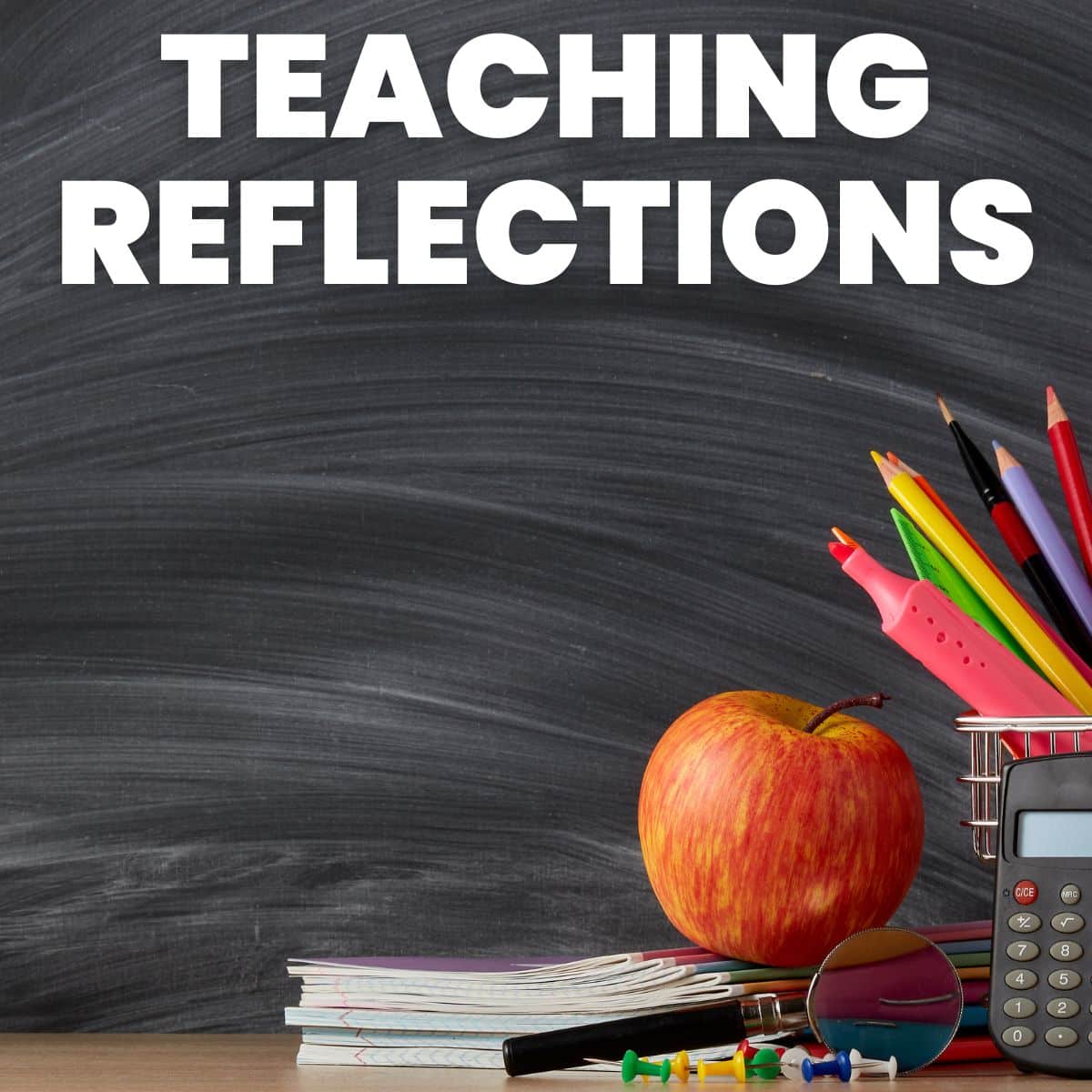Student Teaching Journey
This blog post contains Amazon affiliate links. As an Amazon Associate, I earn a small commission from qualifying purchases.
I started writing this blog Math = Love in 2011 while I was still in college. I have collected my early blog posts and combined them into one single post that captures my journey through student teaching and the search for my first teaching job. It is my hope that future math teachers will find this journey to be interesting and inspiring.
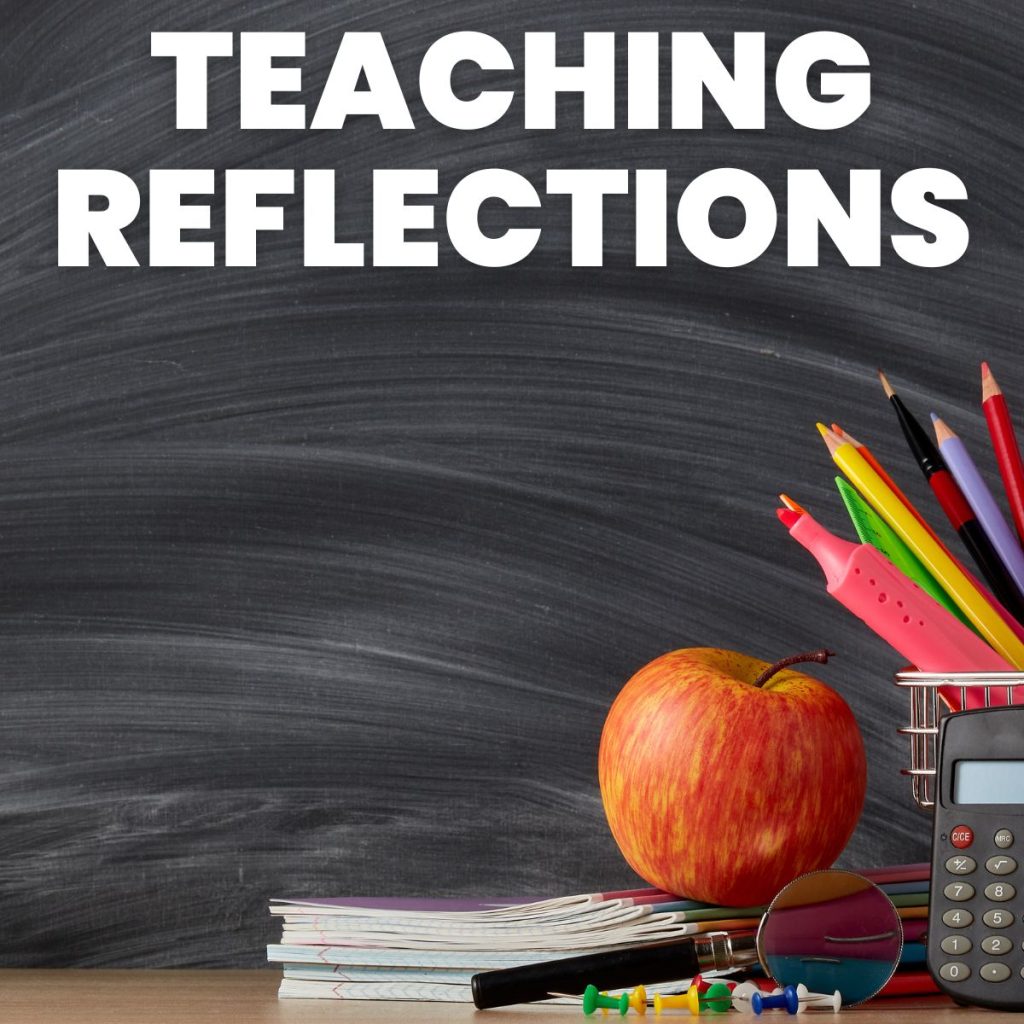
I had no idea that a decade later I would still be writing this blog. I had no idea how much I would truly love teaching math. I had no idea that I this starting this blog would lead to a worldwide romance when I ended up marrying a maths teacher from Australia who had been reading my blog. It turns out math really does equal love.
If you are a student teacher or a soon-to-be student teacher, I have one piece of advice. Write things down. Start a blog. Start a twitter account. Keep a journal. Write down the things you see and experience in your classroom. Capture your thoughts and wonderings. The act of writing is powerful. It is through writing that I do my best reflection. Writing a blog post forces me to reflect on my teaching, and it is when I reflect on my teaching that I become a better teacher.
Join me on my journey towards and through student teaching.
February 16, 2011 – I feel like I’m cheating.
I’ve been waiting to start this blog for ages. I started reading math teacher blogs during my junior and senior years of high school. Now, I’m working on finishing my junior year of college. I’m pursuing a double major in mathematics and secondary education.
So, I feel like I’m cheating in starting this blog since, technically, I’m not a math teacher yet. In fact, I’m not even a student teacher yet. But, I love math and am passionate about education. So, here I am.
The more blogs I read, the more I realize just how much effort it takes to be an effective teacher. During the last several years of living vicariously through math teachers sharing their experiences on the web, my philosophy of how math should be taught has already shifted several times. I’ve started re-evaluating my own experiences with math in the classroom as a student.
It is my hope that this blog will serve as a place to reflect on math and teaching so that I can start learning how to be an effective teacher before I ever enter my own classroom.
October 10, 2011 – Student Teaching
It’s hard to believe that I’ve finally made it to my senior year of college. This semester, I have been observing as well as teaching in an actual math classroom for my methods course. It’s been quite an eye-opening experience. It’s been exciting and frustrating and exciting and overwhelming all at the same time.
At the beginning of the semester, I was terrified to get up in front of the classroom. I had talked with the teacher beforehand, and we had agreed that I would just observe the class during my first visit. Imagine my surprise when I found myself working problems on the board in front of the class. It turned out to be a good thing. It got me out of my comfort zone, but it was necessary. I mean, if I want to be a teacher, it had to happen sometime. It just happened sooner than I had planned…
My education professor came and observed my teaching last week. His first comment to me after watching me teach was “You’ve got confidence up there. I like that.” So, I guess I’ve come a long way in the past six or so weeks since my first experience in front of the classroom.
Math always came easily for me as a student in school. So, a degree in mathematics was an easy choice. Honestly, though, I didn’t realize what a degree in math entailed. Had I known what was meant by topology or analysis, I would have likely ran away, terrified, from this field. However, I didn’t run away. I have persevered, and I am a better person for it. The field of mathematics is a vast, beautiful, and often frustrating subject. As I told someone the other day, “math makes the world a better place.” This is something I truly believe, and I hope to be able to share my love of math, my passion for math, with future generations.
Will they leave my classroom loving math with all their hearts? Most probably not. Will they leave with a better appreciation of mathematics? I certainly hope so.
December 13, 2011 – Student Teaching Placement
Well, it’s hard to believe, but in less than a month, I will be finally starting my student teaching. My student teaching will actually be broken up into two placements. The first two months will be spent in a high school, and the last two months will be spent in a middle school classroom.
It feels like I’ve been waiting for this for ages. This semester, my methods course gave me a taste of what to expect in student teaching. But, I’m looking forward to actually putting into practice all that I have been learning. I have hundreds of great math teaching ideas bookmarked. My entire family questions my sanity because I am constantly interrupting conversations to say that something would make a great math lesson.
After living, breathing, eating, and sleeping math for the past three and a half years, I am ready to teach math. Am I ready, really ready? No matter the answer to that question, my student teaching is soon to be a reality. A reality that will begin January 4th. It’s going to be a journey, and I invite you to join me on this journey. Any feedback, any comments, any help you would like to give, I will gladly accept.
Please join me on my math teaching journey.
January 5, 2012 – Day One Complete
Well, I’ve survived my first day of student teaching. I apologize in advance if this blog post seems fragmented. It is fragmented. After a day of observing and interacting with students, I have so many thoughts floating through my head. Actually, the word “thoughts” in the preceding sentence could be replaced with “questions” as I look back over what I have written. I don’t have the answers to these questions right now. Some of them I may never have answers for. But, I fear that if I do not record them today, they will be lost. Because a hundred new questions and thoughts will likely take their place tomorrow.
Today, I noticed that the majority of problems that students had were with negatives and fractions. Though I was surprised at the fact that many students still struggled with the fact that a negative times a negative is a positive, I was more surprised how many students just ignored the negative signs altogether. It was as if the negative signs were invisible to the students. Why?
The class had been reviewing how to solve inequalities for less than five minutes when this question was posed. My cooperating teacher was quick to remind the students that while they might not use algebra in their lives, they will use the logical thinking skills that algebra teaches daily. To me, math and its applications surround us. Working for my family’s business, I have the opportunity to use algebra on a regular basis. But, I realize I am an exception. How can I make math relevant to my students?
Other than the geometry problems I worked on my teacher certification exam, this is really my first exposure to geometry since my freshman year of high school. Today, I realized that geometry is about the WHY? question. Sure, we ask students to find the measure of angle 2. But, almost always, this is followed up with the question of why that is true. Students are, for maybe the first time, being asked to justify their steps. The fact that students have so little experience talking about mathematics becomes soon evident.
Why do we ask the WHY? question in geometry but not algebra? In algebra, we want to know if students know WHAT we are solving for, WHAT the solution to the equation is, WHAT the slope of the line is, …
January 9, 2012 – Reflections on the First Week
Well, the first week of my student teaching experience has come and gone. Okay, there were only three days of classes, but what an experience those three days were. Thus far, I have only been observing the teacher, grading papers, and circulating the classroom, helping students with their work.
The majority of the things I have learned these past few days have not been about teaching math. Instead, they have been about students. The inner-city school I am completing my student teaching at is part of a different world than the one I was raised in. Students talk candidly about drugs, race, the fear of ending up living on the street. The majority of these students are at risk of not meeting the state requirements for graduation.
Yes, these students need to learn math. But, they need so much more than that. While I feel at least semi-prepared to teach math since I will be graduating in May with a degree in mathematics, I feel quite unprepared to teach these students. How can I relate math to these students who have experienced things in their lives that I cannot even begin to imagine?
January 12, 2012 – A Week of Firsts
Today marks the end of my first week as a student teacher. And, this week has been full of firsts. First faculty meeting. First PLC meeting. First fire drill as a teacher. But, I’m particularly excited to share a first I experienced today that was unexpected.
First time to teach algebra in Spanish.
I wasn’t expecting to teach algebra in Spanish today. While the majority of the students were testing, I was given the task of helping 5 students with their algebra homework. Given a table, they were supposed to graph the points, describe what was happening in words, and write an equation to represent the table.
While the other students had began working, one girl had pulled out pencil and paper, but she had not started her work. After helping some of the other students with their equations, I realized that this girl had still not started. So, I sat down by her and began talking her through how to plot points. However, I soon found out that this student spoke zero English. On top of that, this was her first day of school.
I sat there quietly for about thirty seconds. Then, I proceeded, much to the surprise of the students sitting at the table, to start trying to explain how to plot points in Spanish. I say “trying” because while I took 4 semesters of Spanish in college, I haven’t taken a Spanish class in two years. However, I had some amazing Spanish professors in college who really challenged me and pushed me to learn the language. And, because of them, I still know enough Spanish to have a basic conversation or read a children’s book in Spanish. Was my Spanish perfect? That’s a definite no. Apparently, I said that I was drinking something at one point instead of taking something… I was also informed that my pronunciation was lacking. I guess my “pero” sounds too much like “perro.”
I definitely need to learn some basic math vocabulary in Spanish, though. Knowing the Spanish words for “line” or “point” would have been most helpful today. Despite my major shortcomings with the Spanish language, I am so thankful for the fact that I was able to communicate with this student today. I can’t imagine moving to another state, starting a new school, and not being able to understand a single word that any of your teachers are saying.
This is why I am becoming a teacher. Will I have a major impact on the lives of each of my students? No. But, I can make a difference in a student’s day, and sometimes that’s all it takes. And, I am learning each day that they will have an impact on my life, too.
February 1, 2012 – Time Flies
Well, I haven’t done the best at keeping up with this blog. At first, my excuse was that I didn’t have much to write about from just observing. Now that I am teaching lessons, I have too many things to do and, seemingly, not enough time.
So, without further ado, here are some highlights of the past few weeks.
- Had my first observation with my university supervisor. My lack of nervousness surprised me. The more time I spend in the classroom, the more I know that is where I am supposed to be. He gave me some useful feedback about what I was doing well at and what I should start trying to focus more on. Our follow-up conference was interesting because my professor has no experience with teaching in high school. All of his teaching and research has been done at the elementary level.
- Survived my first SURPRISE observation by the school’s principal. My cooperating teacher had left me in charge of the class for a few minutes while she walked a student to the office. Several minutes later she had not returned. I had started pondering whether or not I should begin going over the bellwork when the principal walked in the door and sat down to observe. So, I just started teaching. The principal only stayed for a minute or two, but I hope I made a good impression.
- I’m finally getting the students’ names down. I’ve discovered that knowing a student’s name is the first step in building a relationship with that student. This morning a student called out to me in the hall. I was able to say good morning and call them by name. The student was pleasantly pleased that I knew his name. There are still a few quiet students in each class that I don’t know their names yet, but I’m getting there!
- I gave my first detention this week. The school just adopted a new tardy policy. One tardy = One afternoon of detention. I learned my lesson, however. I need to wait until the end of the class period to actually give the detention slip to the students. After I gave one student his detention slip, he literally shut down for the rest of the class period. It was a real struggle to get him to do anything.
- Made my first foldable today. It was a three flap foldable over the three ways to determine slope. I don’t think my students have ever been taught how to take notes. It’s always an adventure when I sit down next to a student to help them, and I ask to look at their notes. There are the students who copy down ever mark I made on the board. And, at the other end of the spectrum, there are those students who write down nothing. Though we had already gone over the different equations for finding slope, I wanted the students to review these equations and be able to look them up if they forgot them. So, this morning as I showered I had the epiphany that we had covered three ways to find slope. And, the other day I saw a template for making a tri-fold foldable. We made them in class today, and the students seemed to really enjoy them. Since we were writing with markers on foldables, the students didn’t realize that they were basically rewriting the same things they had already (hopefully) written in their notes. My favorite part of the experience was teaching the students how to use their foldable to help them with their homework assignment. When students told me that they didn’t know what to do, I would ask them which flap of their foldable matched the problem (finding the slope from the equation, graph, or two points). Once they decided which flap to use, all they had to do was open the flap and write the equation down on their paper. Usually this was enough to get them started and working on their own. Yay foldables!
February 12, 2012 – Slope Foldable
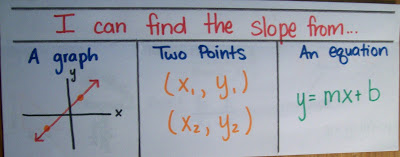
Today I want to share a slope foldable I made for my Algebra 1 students.
I found that my students in Algebra 1 were having trouble remembering the different formulas for finding slope. Before starting our last lesson over finding the slope from an equation, I wanted to come up with a way to review the different methods for finding slope. Having seen some examples of foldables on Kate’s blog, I used her template for a 3-door foldable.
Here are the inside flaps of the slope foldable:
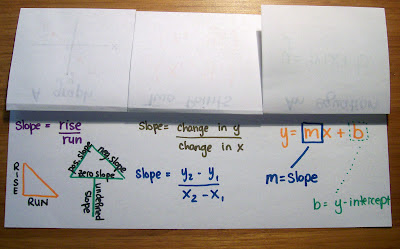
The foldable made the perfect resource for students to use on their homework assignment. When students would ask for help on a question, I would first ask them what type of information they were given in the problem. Once they had decided if it was a graph, two points, or an equation, I was able to direct them to use their foldable to find the correct formula.
February 13, 2012 – 2 More Weeks
It’s hard to believe that I will be at my first placement for only two more weeks! In my experience, the days and weeks go by so much faster as a teacher than as a student. Though I will be sad to leave my first placement, I am very excited that I will be getting to experience a middle school classroom for the second half of the semester. I will be responsible for teaching five sections of pre-algebra.
It’s amazing to me how attached one can get to a group of students in a matter of weeks. It seems like I’m just now starting to build those relationships with my students. Students are opening up to me. They are starting to trust me. Though the students were wary of me at first, I’m afraid that when I leave in two weeks that they are going to think that I have abandoned them. They will especially think this if they discover that I have left them, students at one of the roughest high schools in the city, to student teach at one of the best schools in the city.
In other news, the search for a teaching job is ongoing. So far, the majority of the job postings for math teachers in Oklahoma have either been in the Panhandle or along the Red River. Since I want to stay a little closer to home than that, I am polishing my resume, cover letter, and application packets as I await more job postings. My cooperating teacher told me that I would know what type of school I wanted to work in. How does that work? How am I supposed to know if I’m cut out to work at an urban, suburban, rural, or charter school?
February 20, 2012 – Redefining Failure
The more time I spend working with high school students, I wish I could travel back in time and change how my students were taught to approach math. I have so many students who choose not to participate or share their answer with the class for fear of being wrong. For them, it is better to sit silently and never understand than to speak up and potentially be wrong.
As a math major, I have written many, many proofs. Last semester, I took a class where we proved all of the most important theorems that allow us to do calculus. Unlike math, writing proofs never came easily for me. When asked, I often told people that I chose to major in math because there is only one right answer. Well, as you likely know, proofs are an exception to that rule. There is no one right way to prove something. There are long proofs, short proofs, elegant proofs, and gadget proofs. However I soon learned that the best way to finding a proof that worked was to just start trying. Some days I would spend hours writing down mathematical statements, trying to find connections. Instead, I would find myself surrounded by crumpled notebook paper. With each failed attempt, I learned more about the problem. I gained new insights to further guide my attempts. And, eventually, I would usually discover the right combination of mathematical statements to get my proof rolling. Looking back, it is those proofs that I am most proud of.
A few weeks ago, I came across a passage in a book, If You Want to Walk On Water, You’ve Got to Get Out of the Boat, regarding this topic of failure.
Failure does not shape you; the way you respond to failure shapes you. Sir Edmund Hillary made several unsuccessful attempts at scaling Mount Everest before he finally succeeded. After one attempt he stood at the base of the giant mountain and shook his fist at it. “I’ll defeat you yet,” he said in defiance. “Because you’re as big as you’re going to get–but I’m still growing.” Every time Hillary climbed, he failed. And every time he failed, he learned. And every time he learned, he grew and tried again. And one day he didn’t fail.
John Ortberg
How can I create a classroom culture where failure is not looked at as a defining feature but as an opportunity to grow? Math is learned by doing, by trying, by making mistakes, and by trying again. But, how do I get my students to try?
February 20, 2012 – Week in Review
It’s hard for me to believe that this will be my last week at the high school level. I’m working my hardest to get over an annoying cold during this three-day weekend so I’ll be able to enjoy my students for my last four days.
Last week was an off-week.
Monday. Snow Day.
Tuesday. Valentine’s Day. Too much candy = Hyper Students who would rather do anything than concentrate on their math assignment.
Wednesday. The students had zero energy or motivation. I attribute this to it being the day after Valentine’s Day.
Thursday. AKA the day before a four-day weekend.
Friday. Professional Development Day. Two of the math teachers presented a ton of great ideas. Now, I have all these ideas floating through my head. Venn diagrams made out of hula hoops and post-it notes. Poof Books. Using Smart Responders as a formative assessment.
February 20, 2012 – M&M Scatterplots
Last week in Algebra 1, we used M&M’s to create scatter plots.
Goals for the lesson:
- Be able to define what a scatter plot is
- Be able to find a line of best fit
- Be able to recognize positive correlation, negative correlation, and no correlation
- Review positive and negative slope
First the students were given a sheet of graph paper and a handful of M&M’s. After drawing an x- and y-axis, I had the students scatter their candy over the graph. Jumping straight into vocabulary, we talked about how the scatter plot had no correlation.
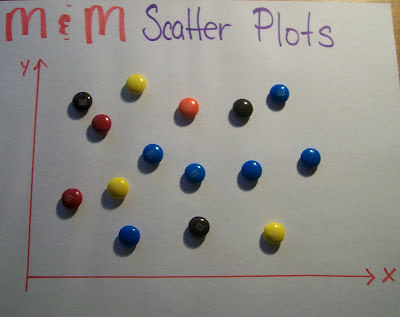
Using the Creative Pen on the Smart Board (set on smiley faces–it was the closest thing I could find to M&M’s), I created a sample scatter plot. Several students took turns coming up to the Smart Board and drawing a line of best fit. Building upon the students’ discussion about how we could draw lines going all different ways, I introduced the idea of no correlation.
Then, I modeled positive correlation on the Smart Board using the Creative Pen again. After a student came up and drew a line of best fit, we discussed that the line of best fit would have a positive slope. (Slope is one of the most-tested topics on the state testing in April. Thus, we are taking any and every opportunity to review slope!)

Students then worked with their M&M’s to construct scatter plots with positive and negative correlations. To check their understanding at the end of the lesson, each student chose one of the three possible types of correlation and rearranged their M&M’s to reflect that correlation. Then, as a class, we looked at the scatter plots of several students to see if we could figure out what correlation they had created.
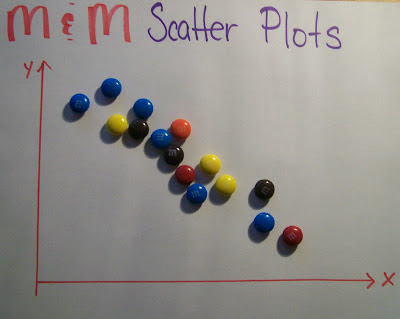
After having each student write what they had learned about positive, negative, and no correlation as an exit ticket, the students finally got to eat their M&M’s.
February 27, 2012 – 8th Grade Here I Come
This past week marked my last week at the high school level. Some of the kids found out that it was my last day, and they were not happy. I was continually asked why I had to go. One girl told me that she didn’t want me to go because she was just now starting to use me as a resource. “How am I going to get caught up with my work if you’re not here to help me?” It was great to here that I have made a difference during my student teaching.
After seven weeks, I can say that I love working with high school kids. Friday, some of the math teachers were giving me their last tidbits of advice for the future. Several told me that they hoped I liked middle school because they knew that they could never teach middle school. I’ve also been told that I will either be cut out to be a middle school teacher or a high school teacher, but I can’t be both. I guess only time will tell. But, I’m hoping to learn to love middle school students, too.
I believe my new cooperating teacher and I are going to get along very well. During this second half of my student teaching, I will have many more responsibilities. Since I will be planning more lessons and teaching much more, I hope to have more useful and informative posts. I will begin by observing his classroom. But, I will soon take over five periods of 8th grade pre-algebra.
My main goal will be preparing these students for their state math test at the end of the semester. So far, most of my teaching has involved introducing a concept for the first time. However, these students will have seen all of these concepts previously. I believe it will be an interesting experience to teach these review lessons, especially because I did not see how the lesson was initially taught.
February 27, 2012 – Middle School Day One
Well, I have officially survived my first day of middle school. And, I can say that the middle school experience is distinctly different than high school. Today, I focused on getting acquainted with the new school as well as starting to build a rapport with the students.
My cooperating teacher loaned me a book to read to give me some insight into the lives and minds of middle school students: Not Much Just Chillin’: The Hidden Lives of Middle Schoolers.
The Highlights of Middle School
- I got the opportunity to help a student open his locker today. I actually ended up having to do the combination three times before it would open. That’s something that didn’t happen at the high school level.
- I also had my first experience working with students who are hard-of-hearing. During two class periods, there is an interpreter. I ended up getting a little flustered while helping one of the students for the first time. Because though I was talking to the student, he was looking at the interpreter. It was difficult for me to see how much the student was understanding.
- One girl adamantly refused to let me help her with her homework. Her reasoning: her sister who is in high school can explain it in a way she can understand. When I asked her if I could try to explain it, she said that my explanation wouldn’t be as good since I didn’t know what she called a popsicle when she was a baby. Umm…
- One boy decided that he and I should have a secret handshake. So, if having a secret handshake had been on my bucket list, I could have crossed that off after today.
March 5, 2012 – Reality
When I met with my cooperating teacher at the beginning of February, he told me that I would be observing for two weeks before taking over the 5 sections of Pre-Algebra. Two weeks, at that time, seemed like a sufficient amount of time to get accustomed to a new classroom and new students.
My first week of middle school, however, has come and gone. I’m learning the importance of setting clear expectations, of ensuring that the students always have something that they should be doing. I’m overwhelmed with names. First names. Last names. Nicknames.
One week from now, I am, essentially, going to be the teacher. And, I’m terrified. As I set down this weekend to start planning, I realized how much I don’t know. My degree is in mathematics, so I know the content. But, I don’t know how much material can be covered in one class period. Should I assign homework? If so, how much? And, what exactly does it look like to review for a state test?
If I had been given a topic to teach, I feel like I would be able to design a lesson to teach that topic. But, I have no single topic to teach. Instead, I have the entire 8th grade math curriculum to review in a matter of weeks. Next week, the students will take two practice tests. So, I will be able to use the results from these practice tests to determine which areas I need to focus my review on.
I have a stack of test review resources to help. And, my cooperating teacher has asked that I incorporate a set of 11 videos of test-taking strategies into my lesson plans. The videos were made by middle school math teachers in California. The students have already seen these videos earlier in the year, but they need to review them before taking the state test in April.
As of right now, my plan is to find sample test questions that each strategy can be used on. Then, each day, students will watch one video. After the video, they will be able to instantly apply what they have learned from the video to a set of sample test questions. I’m hoping that after several conversations with my cooperating teacher everything will fall into place.
In my cover letter, I have written that I believe that learning happens by doing, by trying, by making mistakes. And, I know that the same is true for learning how to be an effective teacher. After trying a certain technique or way of structuring a lesson, I will learn what works best. Not every lesson will be a complete success. But, I can learn something from every lesson that I teach.
Reality has set in. Two months from tomorrow, I will be walking across the stage to receive my diploma. I need to learn everything that I can in the next seven weeks to prepare me to assume my own classroom come August.
March 15, 2012 – Initiation
During my high school placement, I did a lot of observation and a little teaching. The majority of my day was spent working one-on-one with students. I loved it, and I really learned a lot. Now, the first two weeks of my middle school placement were similar. I observed the new teacher’s style, discipline procedures, routines, etc. Whenever students were working, I was circulating the classroom, helping students and answering questions. This week marks the beginning of the actual teaching period of my student teaching. I am fully in charge of lesson planning, grading, teaching, and everything else that goes with being a teacher. I’ll admit that the transition has been slightly overwhelming. This is the first time that I have been able to choose what is taught and how it will be taught. But, I am so thankful for this opportunity because I believe it truly reflects, to the greatest extent possible, what being a teacher is actually like. With only three full days of teaching, I feel like I have already learned a ton.
- Do not let middle school students choose their own groups. Groups, to be effective, need to be carefully selected.
- Always have an activity planned for students who finish early. I had not incorporated this into my lesson plans for the week, but that has been changed. Students know, now, that if they finish the activity early they are to create a problem of their own related to the day’s lesson. For example, my students have really been struggling with proportion problems. Since we’ve been practicing proportion problems this week, I had students who finished early today create problems of their own that can be solved using proportions.
- An organizational system is crucial. In just a few days of teaching, I have become overwhelmed by paper. I’ve kind of made up a system as I’ve gone, and while it has worked it has not been the best. I need to start thinking about how I am going to keep organized when I have a classroom of my own.
Everyday, my cooperating teacher takes a ton of notes as I teach first period. It works out nice since we have second period plan. So, after first hour, we sit down and talk about how first period went. The feedback he has been giving me is most helpful. It’s nice because he writes down both what worked well and what needs some work. Instead of feeling criticized, I often end up feeling encouraged. Because after I finish teaching a lesson, I am usually only focusing on those things that I wish I had done differently or better. So, it is reassuring to hear that, for the most part, the lesson went well. One thing I’ve been working on since Monday is rephrasing my questions. My first instinct is to say, “Mary, how do we find circumference?” I never really thought much of this until my cooperating teacher suggested that I change the order. Instead, I should say, “How do we find the circumference, Mary?” Though it sounds weird to me, I do see the reasoning behind his suggestion. When I preface a question with the name of who it is intended for, many of the students may tune out the question or not attempt to answer on their own since they know they will not be called on. However, if I ask a question without yet specifying the name, all of the students should be thinking about an answer to the question until I specify who I am calling on. I’ve found that this is a hard habit to break. Often, during the week, I’ve already said a student’s name before I remember that I need to place the question first and the name last.
March 26, 2012 – Spring Break
As I type this post, I am laying in bed, eating popcorn, and staring at the piles of boxes that have began to surround me. My Smart Board file for tomorrow is done. Worksheets are ready and printed. It’s the last day of Spring Break. In fact, this week marks my last Spring Break as a college student. My cap and gown are hanging in my closet. Graduation is quickly approaching. And, I have to be moved out of my apartment by the day after graduation, so the packing has began, hence the boxes.
My cooperating teacher suggested that I try to make my Spring Break as relaxing and fun as possible since student teaching can be an overwhelming and exhausting time. I’m not sure if my activities will meet his approval, but I can say that my spring break has been most productive. I fit in a dentist appointment, doctors appointment, and I got my taxes sent off. I wrote my next-to-last essay for my student teaching seminar class. However, I’m most proud of the applications I submitted to thirty different school districts. 28 paper application packets and 2 online applications. This brings my total to 32 school districts applied to. The process of filling out all of these applications and answering the essay questions for many of them has led me to feel much more prepared for the interview process.
I’m both excited and terrified for the changes that the next few months are going to bring. I am most anxious to find out where I will be teaching and what I will be teaching. I’m ready to start making plans of how I’m going to organize my classroom. I want to start planning units and activities.
March 26, 2012 – O Christmas Tree Slope Edition
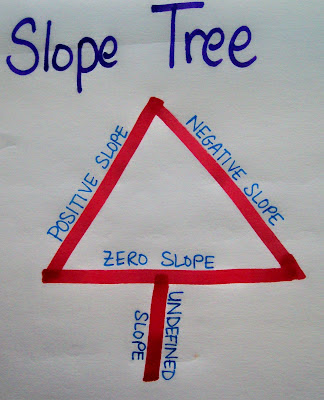
My first cooperating teacher at the high school level shared with me this method of teaching slope. After introducing what slope was, we asked the students to draw a tree in their notes. However, they couldn’t draw just any tree. Instead, they would learn how to draw a special kind of tree.
After drawing the above tree on the board without the labels, the students commenced to criticize the tree and say how it looked more like an arrow than a tree. Luckily, it really doesn’t bother me when students criticize my drawings. I’ll be honest. I am no artist. And, obviously, I have a lot of trouble drawing straight lines. Because the trunk of my tree above actually has a very slight positive slope instead of the intended undefined slope.
We then proceeded to talk about the different kinds of slopes that could exist. As we discussed the different slopes, the students labeled their tree.
Though the students thought it silly, there was something about this tree that made the concept of slope really stick with my students. I can’t tell you how many times over the next month that we continued to reference this tree. I would be working with a student, and I would ask them whether a graph had a positive or negative slope. When they said they didn’t know, I would then ask, “Which side of the Christmas Tree does the graph look like?” As soon as I asked this, they would almost instantly be able to determine if the slope was positive or negative.
You may have noticed this slope tree under one of the flaps I posted of my Slope Foldable*. I thought it deserved a post of its own. This isn’t the only way to teach students to remember the different types of slope, though. Here are links to some other ideas that I have seen around the blogosphere lately. Math Hombre featured Mr. Slope Guy recently on his blog. I Want to Teach Forever shared an Alphabet Slope Activity. If you know of any other creative ways of teaching slope, I’d love to hear them in the comments!
Fair Warning: If you remind students to draw the Christmas Tree on their foldable to help them remember the different types of slope, one student may draw an actual Christmas tree, complete with ornaments, but lacking any mention of types of slope. Weeks later, when you mention that they should look at the Christmas tree on their foldable, they will proceed to show you the Christmas tree they drew and ask how that will help them with their current math problem.
March 30, 2012 – Job Interview Next Week
I received the magic call today to schedule an interview for a middle school math position. The interview isn’t until next Thursday, so I have a week to prepare.
My cooperating teacher suggested that I prepare a portfolio of activities, lesson plans, etc that I am proud of to take with me to the interview. So, I’ll be working on putting this together over the next few days.
April 4, 2012 – Portfolios, Interviews, and Exponent Rules
Portfolios and Interviews
So, I have less than two days left to obsess over my upcoming first interview. I’ve been researching the school district to find out as much as possible about it. There isn’t much information on the school website, but I did read through the middle school handbook to get a feel for the school.
My portfolio is ready and assembled. I feel so professional having a portfolio. It contains my resume, test scores since I have not received my teaching certificate yet, transcript, student teaching evaluation forms, two sample lesson plans, and copies of the curriculum I created to help my 8th grade pre-algebra students prepare for the 8th Grade Math OCCT Test. I also included my slope foldable in the front pocket.
I also spoke with a principal today of a different school district about setting up an interview for next week! This would be a high school position where I would have more opportunities to determine what courses I would be teaching. I should have a specific date for this interview in a few days.
Exponent Rules
In other news, my 8th graders are still reviewing for our upcoming OCCT test. We have been reviewing exponent rules, how to multiply and divide numbers in scientific notation without a calculator, when to flip the sign on an inequality, measures of central tendency, and more. To help the students remember that we subtract the exponents when dividing, I told them that the division bar looks like a giant subtraction sign. I’m hoping that this mental image will help them remember what to do with the exponents. However, when students do remember to subtract, many of them will subtract the exponents and then say that number as the answer. So, m to the 9th power divided by m to the 6th power equals 3 in their world.
I was talking to the Algebra 1 teacher next door about teaching exponent rules, and she said that she tells her students that “a power to a power is very powerful” so we have to multiply the exponents. Every time the students encounter a problem, she makes this statement, emphasizing the words “very powerful.” Then, she makes her students repeat the sentence. So, by the end of the school year, the students understand how to take a power to a power.
If anybody has any creative suggestions on how to explain to students when to add the exponents, I would love to hear them. If students are having trouble understanding, I like to have them write out the problem without exponents. So 2 cubed becomes 2 * 2 * 2. And 2 squared becomes 2 * 2. So, 2^3 * 2^2 = 2 * 2 * 2 * 2 * 2. There are 5 2’s so that is the same as 2 to the 5th power.
April 6, 2012 – Interview Numero Uno
Well, I’ve officially survived my first interview. And, I think it went pretty well. I thought it was going to be quite nerve-racking, but I was surprisingly calm throughout the interview.
It was with the principal and counselor, but the counselor didn’t say anything at all during the interview. I was able to give a lot of examples of student successes and tell about experiences I have had with students during the interview. Instead of feeling like an interview,it almost felt like an hour long conversation.
Looking back, I would have answered some questions slightly differently. Sometimes after starting to answer something, I would realize I wanted to answer the question in a slightly different way than I had first intended. I was able to answer all of the questions. Some of my answers were just not as eloquent as I would have wished. But, this is a learning experience. With each interview, I’m sure I will feel more comfortable in my answers.
The principal did give me the list of questions he was going to use and let me look over it for a few minutes before we started. But, it didn’t feel like a scripted interview. Instead, the conversation sort of flowed from topic to topic. Some questions would be rephrased in light of something I had just said. The principal laughed, smiled, and made some jokes throughout the interview so I took that as a good sign.
I didn’t ask about the timeline for the hiring process, but the principal told me his plans while he was walking me to the front door. He is planning on doing more interviews next week, and he intends to make a decision by the end of next week. But, the board of education won’t vote on it until May. He said that since we had a face-to-face interview, he would call and let me know his decision either way.
My thank you notes to both the principal and counselor are written and stamped and waiting to be mailed tomorrow. He did bring up technology at the very end of the interview, and I didn’t have much of a chance to elaborate on my experience with technology. I’m currently taking a
class in educational technology and our assignment this week is to create an online portfolio of all the work we have done this semester using technology. So, I’m planning on finishing up that portfolio this weekend and e-mailing the principal with a link to it.
April 17, 2012 – Exciting News
I’m hesitant to post this for fear that hitting “publish” will cause me to wake up and realize that the events of the past few days have just been a dream.
My story begins on the afternoon of Friday the 13th. During the passing period, I checked my cell phone to see that a superintendent had left me a voice mail. Several weeks ago, I had submitted my cover letter, resume, transcript, test scores, and student teaching evaluation forms to this district in regards to a high school math opening. After teaching sixth period, I stepped out into the hall to return the call since my cooperating teacher teaches seventh period each day. This was at 2:30 pm.
The superintendent asked if I had accepted a job yet. If not, he told me that he would love to interview me. I told him that I hadn’t accepted a job and that I would love to interview with him.
When I told him that my schedule was very open and flexible, I didn’t expect to have an interview that very afternoon. His response was “How fast can you get here?” Since my cooperating teacher was teaching, I was able to leave school immediately and drive directly to the town the school is located in.
At 3:45, I arrived in the town. The superintendent actually took the time to drive out to where I was and lead me back to the high school. I’m very thankful for this because I left the school in such a hurry that I didn’t even have a chance to look up the address of the school. Less than twenty minutes into the interview, he offered me the job. By 5:00, I had been given both a tour of the school and the town. It was a whirlwind of an afternoon.
I have accepted the position, but nothing will be official until the board of education votes on it in early May. I can’t even begin to express what a relief it is to have a job lined up before graduation. I still have 2 weeks of student teaching left. But, I can mark “find a job” off my to-do list.
Now, I can’t wait to figure out exactly which math courses I will be teaching! So excited…
April 22, 2012 – Last Week of Student Teaching
Well, it’s hard to believe, but I’m preparing to embark on my last week of student teaching. This experience has taught me so much about teaching, but it has also shown me how much more I have to learn. In less than two weeks, I will be a college graduate. It sounds so weird to say that. I feel like I’ve been a student forever.
I’m hoping to find some time this week to blog about the mini-unit I did on probability with my pre-algebra students last week. But, first I need to finalize the projects my students will be working on this week.
April 30, 2012 – Finished
Student Teaching…Finished.
Educational Technology Final…Finished.
College…Finished.
All that’s left is to walk across the stage on Saturday. And, I will be an official college graduate.
I’ve got a lot of exciting posts planned for the next couple of weeks. I want to share the games and projects I used with my 8th grade students after state testing was over. I want to use this blog as an opportunity to reflect on my student teaching experience. What worked? What didn’t work so well? I need to figure out exactly what I should be working on this summer as I prepare for my first teaching position.
July 22, 2012 – A Reminder to Myself
Dear Sarah,
In a little more than three short weeks, you will officially be a high school math teacher. Though you are incredibly excited and have so many plans and ideas, the challenges that come with being a first year teacher will soon seem overwhelming. Some days your lessons will lack creativity. Other days, it will take all your energy just to make it through the day.
Remember the lesson you walked away with from your student teaching experience. Everything you do, every day you do it, makes a difference in the life of a student.
Love,
Sarah
My cooperating teacher at the middle school level gave me two amazing presents on my last day of student teaching. First, he presented me with a name plaque to set on my desk. His cooperating teacher had given him one, and he continued the tradition. Receiving this made me feel like a real teacher for the first time.
The second gift, though it cost him nothing, has become one of my most treasured possessions. On the last day, he had each student write me a letter. They had to tell me three things they liked about my teaching, three things they learned, and write me a special message.
I ended almost all of my college application and scholarship essays with the following sentence: “A teacher’s profound influence may never be fully known, but unlike fleeting fame and wealth, it is immortal.” This precious stack of letters gave me a peek at the extent to which a teacher impacts lives. I read letters from students I thought I had not impacted that made me cry. Other students wrote of small things I had done that I never would have dreamed would have made a difference in their lives.
When teaching gets tough, I will turn to these letters to remind me what teaching is all about.






This is why I teach.
July 26, 2012 – OERB Workshop
Well, I attended an OERB Core Energy Math Workshop today. It was my first professional development workshop, and it was pretty much like Christmas in July. It was a workshop hosted by the Oklahoma Energy Resources Board. I attended the workshop for high school math teachers. We learned about how to teach math while teaching students about the oil and natural gas industry at the same time. Teaching topics included scatter plots, inequalities, writing equations for cost, revenue, and profit, measuring angles, distance formula, and more.
OERB was incredibly generous. Free lunch. Free snacks. $50 stipend for attending. A Copy of the Entire Curriculum. And Math Teaching Goodies!!!
OERB Core Energy Math Workshop Supplies
The previous statement totally deserves the triple exclamation points, too. Especially when you consider the fact that we got $450 worth of supplies, including an entire class set of scientific calculators! Considering the fact that the only calculators I found in my classroom were 4 calculators from the dollar store, I am beyond thrilled.
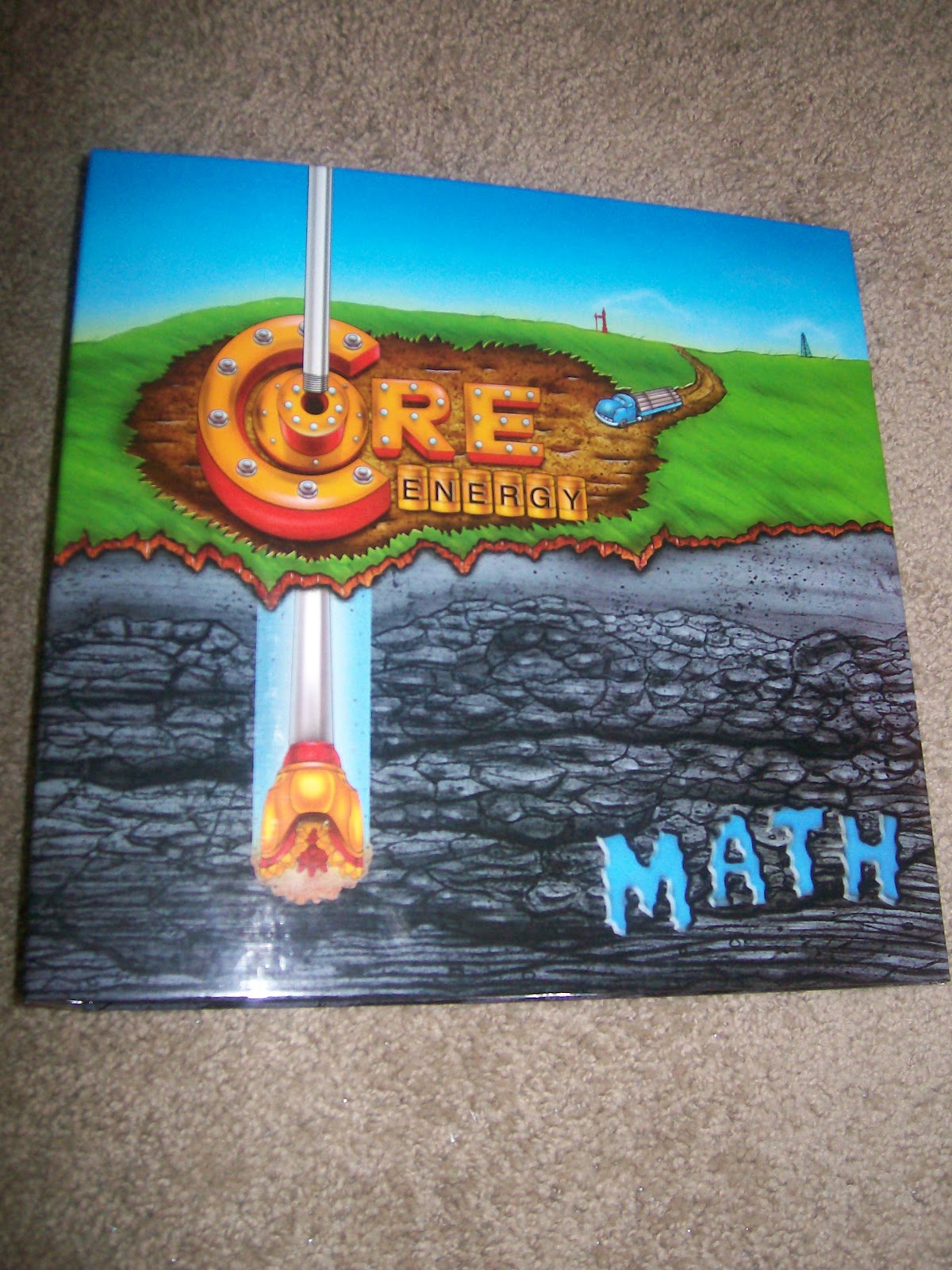
6 packs of colored pencils, 500 sheets of graph paper, and 30 protractors!
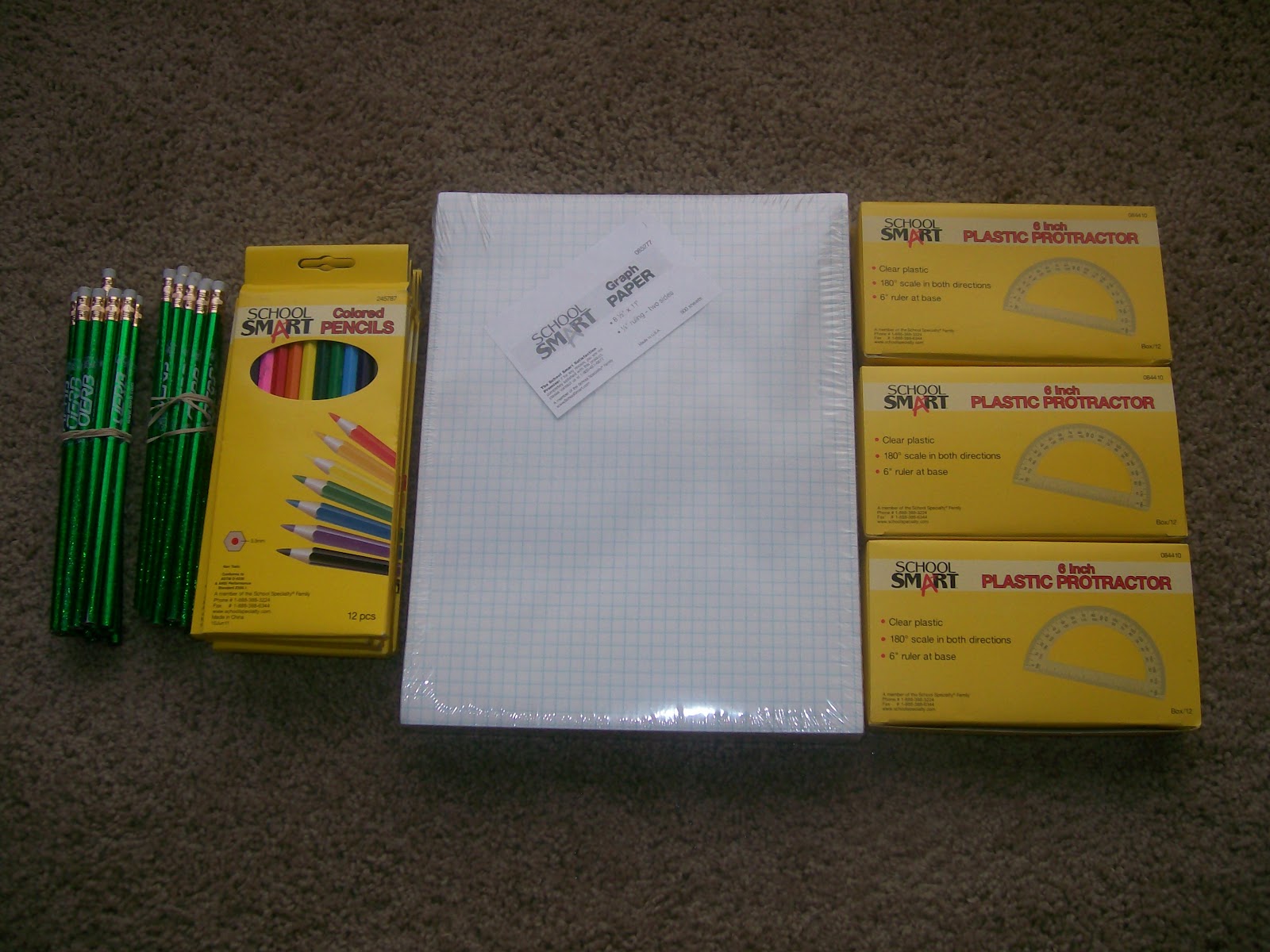
SCIENTIFIC CALCULATORS – An entire class set of 30 TI-30XS Calculators!

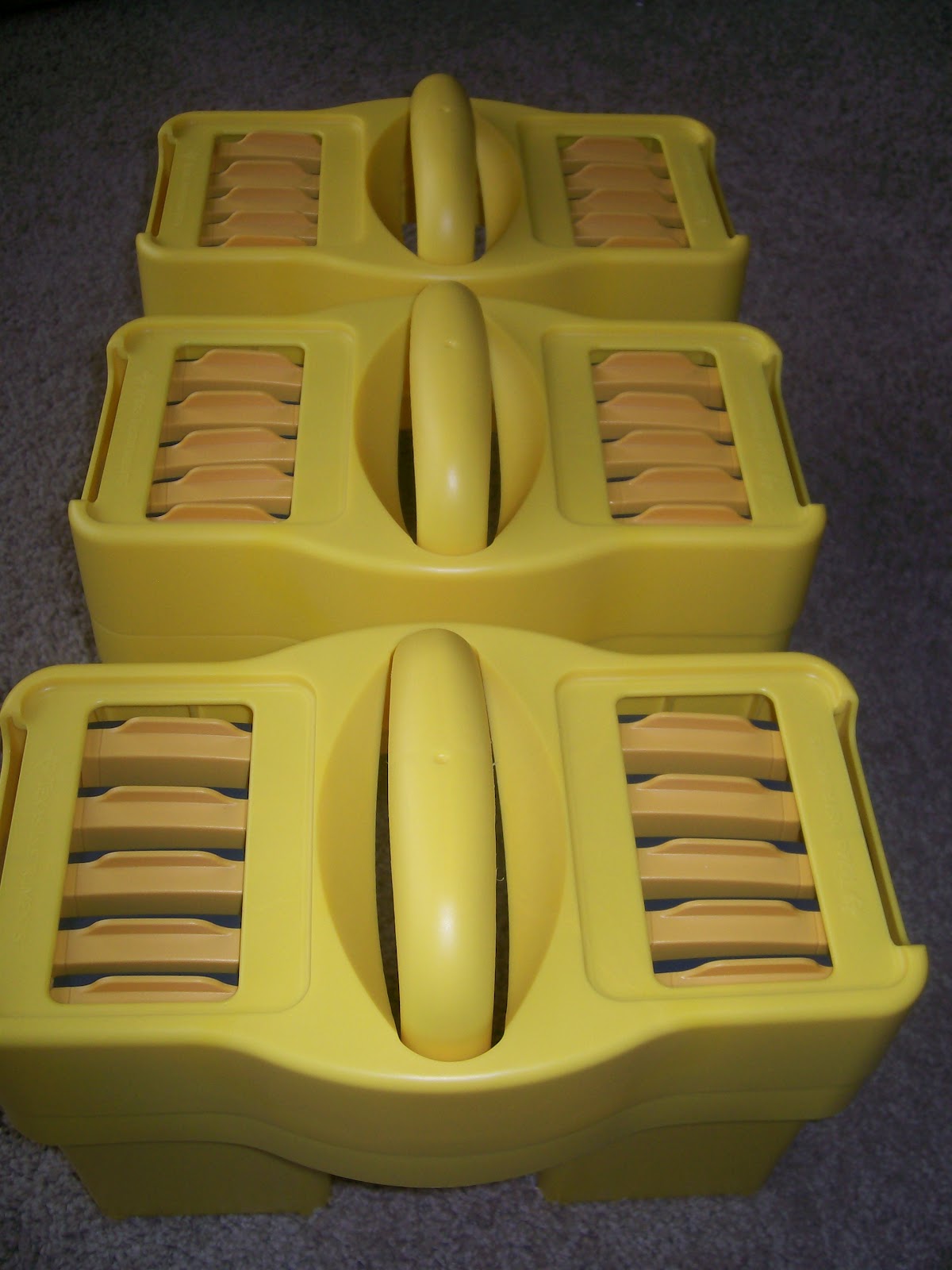
So, if anybody from the OERB ever happens to read this, thank you! You have no idea what a blessing this is to my classroom and my students. Thank you!

